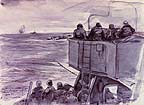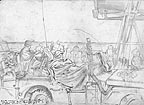 LST
in Channel Convoy
LST
in Channel ConvoyMitchell Jamieson #212
Ink & wash, June 1944
88-193-HK
The training was finished, although the invasion troops did not know that until they were on their ships headed across the English Channel on the night of June 5-6, 1944. Once on board, they received their first briefings as to what their missions would be. After that they were left to make such preparations as were needed or to be alone with their inner thoughts. In the pre-dawn hours of June 6, the invasion troops would receive the traditional pre-invasion breakfast of steak and eggs, after which they would take up personal weapons and equipment and stand by, waiting for the order, "Land the landing force!"
 LST
in Channel Convoy
LST
in Channel Convoy
Mitchell Jamieson #212
Ink & wash, June 1944
88-193-HK
A view on board an LST, looking forward from the bridge, with the main deck below fully loaded with trucks, anti-aircraft half-tracks, jeeps, and trailers. Ahead and on both sides were other LSTs in the group, each towing its "rhino" ferry which was manned by skeleton crews of Sea Bees, the rest of the crews being on board the ships themselves. With the LSTs prevented by German artillery fire from coming to the landing beaches to unload, it was the job of the "rhinos" to unload the tank deck of each LST and go to the beach. Then, since the "rhinos" could only make a couple of knots an hour, the LSTs had to be unloaded offshore by LCTs. Later, when the beach was secured and the ships could come in closer, these "rhinos" operated a continuous shuttle service, unloading all types of ships. This LST, with its mobile anti-aircraft vehicles on deck in addition to the ship's own anti-aircraft batteries, could put up a formidable screen of anti-aircraft fire. The anti-aircraft half-tracks were of two types: one carrying four quad-mounted 50-caliber machineguns, and the other with one 37mm anti-aircraft gun and two 50-caliber machineguns. The rear part of the half-track was where the gun turret was mounted. A soldier who sat with the gunners operated the turret electronically. Trucks carrying supplies and ammunition, with plenty of camouflage netting, are depicted on the main deck below in the foreground. There were about the same number of vehicles on the tank deck below, unseen. This was the evening of D-day minus two (June 4, 1944).
 Destroyer
Letting Go Depth Charges Off Stern D-Day Minus 1
Destroyer
Letting Go Depth Charges Off Stern D-Day Minus 1
Mitchell Jamieson #V-36
Charcoal, pen & wash, June, 1944
88-193-RM
One of the dangers to the invasion fleet was the threat of German U-boats attacking the tightly packed ships. Nazi submarines had proven their ability to wreak havoc on Allied trans-Atlantic cargo and troop convoys from the beginning of the war, so they posed a significant threat. In the days before D-Day, Allied destroyers and other anti-submarine warfare ships patrolled the English Channel to destroy or drive away any lurking enemy subs. The U.S. Navy destroyer here unleashed its depth charges (barrels of high explosives detonated underwater by time fuses) in an attempt to destroy a suspected German submarine contact. The high water plume on the horizon shows where a depth charge has exploded. The destroyer’s crew was at "general quarters" battle-stations, with each officer and sailor wearing a steel helmet and life preserver.
 Deck
of LST #150; Combat Loaded
Deck
of LST #150; Combat Loaded
Mitchell Jamieson #224
Pen & wash, 1944
88-193-HZ
Men off duty passed the tedious hours by playing cards while AA gun crews kept a close watch for enemy aircraft
 Killing
Time Enroute to Normandy
Killing
Time Enroute to Normandy
Alexander P. Russo #13
Ink & charcoal, 1944
88-198-M
Once the invasion troops were loaded on board their transports and the fleet was underway, the crossing to the Normandy beaches took hours. With nothing to do below decks, the troops read books and magazines, played various card and dice games, wrote letters home, talked to buddies, or just did whatever came to mind. With the prospect of the next morning’s landing prominent in their minds, it is doubtful if many of the troops slept much on the night of 5-6 June 1944.
 Seaman
Sleeping in Hammock on Deck
Seaman
Sleeping in Hammock on Deck
Mitchell Jamieson #V-43
Charcoal & wash, June, 1944
88-193-RU
An "off-watch" sailor used his precious off-duty time to catch up on sleep. Watches went on 24-hours per day at sea, four hours on and four hours off (except during general quarters, when everyone was on duty), so sleep was taken at every opportunity. Crowded troop and cargo ships resulted in a shortage of fixed bunk-beds (or "racks"), so this seaman resorted to the tried-and-true hammock, swung from an overhead beam.
 Rubber
Boat and Men Cleaning Rifles
Rubber
Boat and Men Cleaning Rifles
Mitchell Jamieson #211
Watercolor, June 19 1944
88-193-HJ
Once the invasion fleet was underway, invasion troops on the crowded deck of the LST made ready for the landing, giving their rifles and equipment a final going over. Most of the troops on board this LST were members of a mobile anti-aircraft outfit, but there was also a naval demolition unit aboard. Their rubber boat for carrying explosives is shown to the right. Another is on top of the trailer in the middle of the picture.
 Gas
Mask Drill
Gas
Mask Drill
Alexander P. Russo #12
Gouache, 1944
88-198-L
Men on board an LST test their gas masks enroute to Normandy beach. The Germans did not use chemical weapons against the invasion forces at Normandy. However, memories of deadly gas warfare and the massive casualties it caused in World War I ensured that Allied forces were well-equipped with gas masks. Gas-mask drills consisted of the user quickly donning his mask and ensuring that there was a gas-proof seal between the face and the mask, then clearing any gas out of the mask by blowing and testing how well the breathing filter worked.
Conference
Aboard LST
Mitchell Jamieson #234
Ink & wash, circa 1944
88-193-IM
As H-hour approached, a small group of men unrolled maps and with the utmost concentration went over the plan of attack. The moment was almost at hand when their months of training, planning, and rehearsal would be put to the acid test.
 Conference
Aboard LST
Conference
Aboard LST
Mitchell Jamieson #V-36 (reverse side)
Pencil, 1944
88-193-RM(b)
Study for above: "Conference Aboard LST."
 Early
Morning; Invasion-Bound Jeep With Waterproofing
Early
Morning; Invasion-Bound Jeep With Waterproofing
Mitchell Jamieson #V-72
Pencil, circa 1944
88-193-SY
A light General Purpose ("jeep") vehicle was on the main deck of a transport. Soldiers used the seats of the jeep as a place of repose while their comrades lined the rail on the opposite side of the ship. The hose coming out from under the jeep’s hood was a breather, to allow air intake into the engine if the jeep was temporarily submerged while driving from the LST to the shore. Also visible is the stern of a landing craft supported by davits.
1 2 3 4 5 6 7 8 9 10 11 12 13 14 15 16 17 18 19 20 21 22 23 24 25